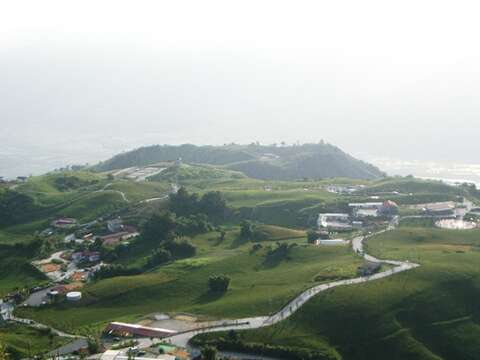Bright, Orange Blossoms of Late Summer--Daylilies of Liushidan Mountain
Updated:2025-07-24
4320
(By Cheryl Robbins)
In early August, the daylily season begins on Liushidan Mountain in Fuli Township of Hualien County and can last for two or three months. As the name suggests, these bright orange flowers bloom for only about a day. They are cultivated and traditionally used to flavor soups, although in recent years, new dishes have been created using these blossoms. During the daylily season, visitors to Liushidan are rewarded not only with the beauty of these blooms, but also with panoramic views of the mountain's breathtaking natural scenery and the East Rift Valley.
To be used as food, these flowers must be harvested before they bloom. In recent decades, to promote tourism to this area, farmers have been encouraged through subsidies to allow some of their daylilies to bloom. The result is Mother Nature’s masterful artwork, with verdant rolling hillsides decorated with splotches of bright orange. During this time, due to the large number of visitors, the public is discouraged from driving up and down the narrow mountain roads and parking lots, and shuttle bus services are put into operation. At other times of the year, this is a much quieter mountain retreat.
Daylily cultivation was originally concentrated in southern Taiwan, especially on Alishan (Ali Mountain) in Chiayi County. In 1959, a typhoon claimed hundreds of lives and buried tens of thousands of hectares of farmland in a thick layer of sand and mud. Some of the affected farmers chose to move to Hualien to rebuild their lives and the daylily fields of Alishan have since been replaced by tea and coffee plantations.
In addition to the mountain views and fields of blooming daylilies, there is a community of indigenous people here that has insisted on preserving traditions. Residents have shunned modern amenities such as electricity and mobile devices. At night, instead of harsh indoor lighting, there is the flicker of kerosene lamps and the twinkling of stars.
For more than 60 years, Cihara'ay, the name of this community in the indigenous Amis language, has not had electricity, and thus, residents began referring to it as the Heian (Dark) Community, by which it is now better known. Cihara'ay was established during the Japanese occupation of Taiwan (1895-1945) when a resident of the neighboring Amis community of Talampo heard a local hunter talk about a plateau that was good for cultivating crops, located above a river. He passed this information on to a family in Olalip (today's Hegang Community). This family indeed found this to be a good place and first grew tobacco and then, more successfully, sweet potatoes, taro root, millet, corn, and seasonal fruits and vegetables. After World War II, some residents from nearby Talampo began moving into Cihara'ay, expanding this community. Early on, there were no roads connecting Cihara'ay with Liushidan Mountain, and a trail that followed the river was created to carry the harvests to market. Later on, as Chinese farmers began moving to Liushidan, the local farmers’ association suggested the growing of daylilies, a high value economic crop. The Amis of Talampo and Cihara'ay followed this advice and continue to grow this crop organically.
Although the residents of the Cihara'ay Community followed up with local government authorities for many years to gain access to electricity, as of 1998, electric poles had been installed only up to the community's entrance. The 34 households that make up the Cihara'ay Community today reached a consensus to protect the environment and not pursue the installation of additional electric poles. They instead seek opportunities to use solar or wind power.
Community residents have developed ecotourism itineraries that include river tracing and hiking the old trail to market, which are led by the residents themselves. Without access to television or modern communication devices, it is easier to observe the signs of nature all around, such as the tracks of wild boar, the silhouettes of mountain goats as they traverse a cliff, and in the summer, the blinking lights of fireflies at night.
Thus, year round, Liushidan Mountain offers numerous photo taking, ecotourism, agritourism, and cultural tourism opportunities. In addition to visiting during its most colorful time—the daylily blossom season—experience the variations in its picturesque beauty at different times of the year.



